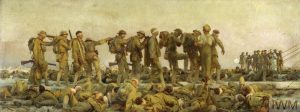My Father was sure that Patrick came back from the Front on a stretcher three times. I can only find hard evidence of two occasions. The first time was in October 1914. He arrived back in England on 16th October. I have found no records that contain any details of his injuries. He was taken to 2nd Eastern General (Military) Hospital in Brighton (see 2nd Eastern General Hospital). He wasn’t transferred to the 3rd (Reserve) battalion until 6th January. This appears to indicate that his recovery was protracted. The soldiers used to refer to a ‘blighty’ wound. This is one that is serious enough to require treatment back in ‘dear old blighty’ (England). I cannot see how it is possible to have a slight ‘blighty’ wound. And yet his military history sheet says that he was only slightly wounded. Perhaps the standards were different in those times.
The final time that he came back to England on a stretcher was in June 1918. (Covered in ‘Another year, another hospital’) This trip marked the end of his military service.
If there was a third time (and I have no reason to doubt it) then he must have been treated in France. My Father said that Patrick was gassed at some point. Every morning he spent time coughing when he woke up. This is another reason why work as a labourer was out of the question. He could have been taken on a stretcher to one of the hospitals on the coast of France. (There were nine hospitals recorded in the vicinity of Etaples.) Depending on which gas he inhaled, and how much, he could have been deemed fit to return to his unit within a relatively short period.
I went back to the Battalion War Diaries to search for evidence to back up this theory. Poison Gas was first used against Allied forces in April 1915. This particular action is known as the Second Battle of Ypres. Chlorine was used against French forces. At the time, Patrick was serving in the 1st Battalion of the Manchester Regiment. They were present, but in another part of the line. There is no mention of casualties due to gas.
I continued looking, knowing that absence of evidence is not necessarily evidence of absence. In March and April 1918 (when Patrick was back in the 2nd Battalion) there are frequent references to casualties due to gas. The German spring offensive was launched on 21st March. On that day, the Diary refers to being shelled with a mixture of High Explosive, Phosgene and Sneezing Gas (Diphenylchlorarsine). Casualties due to gas attacks were recorded quite frequently during April. The numbers are quite small. This indicates that gas filled shells were used, as opposed to the mass release of gas that took place in 1915. The victims were usually evacuated very quickly (on stretchers!). Some poisons could be passed on by contact. It was necessary to remove traces left on clothing. It is probable that Patrick was gassed during this period. I have to admit that the evidence is thin. Evidence that he was gassed at any other time is even thinner. Pressure on manpower was extreme by this stage in the war. As an experienced soldier, Patrick could have been sent back to his unit even when not fully fit.
The impact of a gas attack has already been covered, albeit indirectly, in an earlier blog (Poetry Please Part 2)

Copyright: © IWM.
Footnote: Diphenylchlorarsine continues to present a problem. Negotiations are ongoing between China and Japan over the safe disposal of stocks (left in China, but made by Japan) that are nearly 100 years old.
